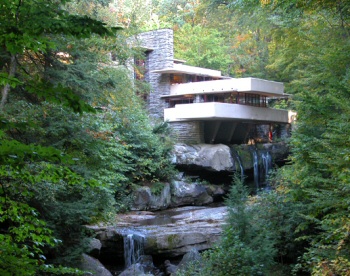Fallingwater, Pennsylvania, USA
Architect
 Frank Wright is one of America's most famous architects. He designed a very special house for his client that is constructed over a waterfall and the home is appropriately named Fallingwater, in Pennsylvania. It became famous instantly and today the structure is a National Landmark. Frank Wright was an American architect born in 1867 who designed over 1000 structures and completed more than 500 works. He was an architect who believed in designing structures that were in synchronization with the environment, an idea he liked to call organic architecture.
Frank Wright is one of America's most famous architects. He designed a very special house for his client that is constructed over a waterfall and the home is appropriately named Fallingwater, in Pennsylvania. It became famous instantly and today the structure is a National Landmark. Frank Wright was an American architect born in 1867 who designed over 1000 structures and completed more than 500 works. He was an architect who believed in designing structures that were in synchronization with the environment, an idea he liked to call organic architecture.
This philosophy was illustrated in his design for Fallingwater, which has been called the best work of American architecture. His works included numerous innovative examples of different building types such as museums, skyscrapers, schools, offices and hotels. He also designed many of the elements of the interior of his buildings. Frank Wright was also a popular lecturer both in Europe and the United States. His private life frequently made headlines, most especially for the fire and murders at his studio in 1914.
Design and Construction
Preliminary plans began in 1935 for Fallingwater designed by Frank Wright. The plans called for a house built partially over a waterfall in the highlands of Pennsylvania's Allegany Mountains. Final plans were approved in 1936 and construction began on the main house and bridge. After its completion in 1937, the structure was hailed as the most beautiful work to date of Wrights. The structure was undertaken by Frank Wright and staff engineers. A rock quarry provided the stones for the walls of the house. Wright assigned his apprentice to the overseeing of the work and only made periodic visits during construction.
Fallingwater strongly represents Wright's passion for Japanese architecture with the strong emphasis being placed on the harmony between nature and man. The home is build over an active waterfall and flows below the house. The fireplace and the house integrates boulder found on the site. A ledge rock that protrudes through the floor in the living room was left in place to link the inside with outside. The rock floors give the illusion of rocks protruding from a flowing stream. Incorporation of the surroundings is in every detail.
The organically designed structure was intended as a nature retreat for the owners. A stairway from the living room leads directly to a stream and a spring trickles inside and then the water is channelled back out. The bedrooms are purposely small to persuade people to gather in open areas. The sound of the river spreads through the entire house. The design incorporates broad windows and expansive balconies that reach out to the natural surroundings.
History
Mr. Kauffmann was a successful business man and president of the Kauffman Department Store. Fallingwater was the Kauffman family weekend residence from 1937 to 1963.The property was then donated to the Pennsylvania Conservancy in 1963 by the son. It is now listed among one of the places to visit before dying by the Smithsonian Life list. In 1991, members of the Institute of Architects named the structure the best overall work of American architecture. In 2007, the design made the list for favourite architecture in America.
Current Use
Fallingwater then opened as a public museum in 1964 and is currently still operating as such. As of 2008, there have been almost 6 million visitors to the museum despite its remote location in Pennsylvania. Today the museum hosts over 150,000 visitors each year. In 1966, Fallingwater was selected as a Historic Landmark.
